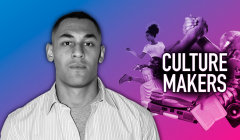
‘Subculture is the most powerful tool we have’
Louis Persent, Co-Founder and Creative Director at Weirdo on the power of embracing the niche

There will be an estimated 1 trillion connected devices by 2015. Very soon you won’t need to hunt anxiously for your shoes in the morning, you’ll Google them. Two opening lines from Andy Hobsbawm from Evrythng who came to speak at FCB Inferno about the possibilities of connecting smart technology with everyday objects.
This reminded me of an essay I once wrote about making the everyday extraordinary. I was mainly commenting on how in 1917 Marcel Duchamp took a standard urinal turned it upside down, signed it R.Mutt and submitted it for the exhibition of the Society of Independent Artists. It was rejected, but that didn’t matter, the conversation had already been started.
Today the urinal has the potential to have its own conversation. Andy talked about a world where all products have their own digital life, where the same visceral observation of objects is necessary to understand the potential of its digital online profile. Imagine if the urinal could let you know you’re lacking in vitamin C. It could then chat to your fridge who would make sure it ordered some extra oranges in your next shop… you get the picture. It’s not just an object for a new age of art, but one for a new age of data, and using that data to improve the quality of our lives without impacting on our daily routines.
This is not a new idea, we already have smart objects helping us in our daily lives – Two Andy mentioned were pay as you go insurance premiums, risk adjusted based on driving habits or Nest’s intelligent thermostat making heating your house more efficient. Both are examples of brands already using data in a useful way. The latter having just been bought by Google for $3.2 billion.
Medicine is where it starts to get really exciting. The smart pill is an ingestible capsule that measures pressure, pH and temperature as it travels through the body. It minimises down time and eliminates exposure to radiation. With an ever expanding population technology like this will be vital to keeping us healthy.
Andy didn’t just want to talk about new products, but the potential of using smart technology to make existing everyday objects smarter – work with things that are connectable not just connected. Mobile technology enables us to act as the link between object and internet. Once the two are connected the possibilities are vast.
If all products can have a digital life it’s the challenge of agencies to understand its digital identity, what would it want to do? The light bulb that wants to go to sleep or the high-heeled shoe that wants to go to a party. They need to figure out how to connect the potential of the technology with the want of the product and the need of the consumer. This connection, or relationship will be key to ensuring the result is personal, dynamic and adaptable. As Stefan Olander, vice-president of digital sport for Nike said – ‘Once you have established a direct relationship with a consumer, you don’t need to advertise to them’
Looks like you need to create a Creativebrief account to perform this action.
Create account Sign inLooks like you need to create a Creativebrief account to perform this action.
Create account Sign in